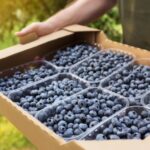Agronometrics in Charts: The economic landscape of Chile’s agriculture sector

In this installment of the ‘Agronometrics In Charts’ series, Sarah Ilyas studies the economic outlook of Chile’s agriculture sector. Each week the series looks at a different horticultural commodity, focusing on a specific origin or topic visualizing the market factors that are driving change.
Chile's agriculture industry stands at a crossroads in 2024, grappling with both challenges and opportunities. According to the Economic Outlook for Chilean Agriculture report published by the USDA, the sector has experienced notable growth in recent years, contributing significantly to the country's GDP. However, persistent issues such as drought, political uncertainty, and evolving trade dynamics present formidable obstacles to sustainable growth.
Despite a period of economic stagnation in 2023, Chile's agricultural sector has remained resilient, with steady growth in GDP. The USDA report indicates that the country’s agricultural GDP reached $28.9 billion in 2023. The projected GDP growth of 1.25 to 2.25 percent in 2024 signals a potential rebound, driven by an anticipated recovery in consumption. This presents opportunities for U.S. exporters seeking to capitalize on Chile's expanding market.
One of the most pressing challenges facing the Chilean agriculture industry is the prolonged drought, which has persisted for over a decade. Drought conditions have particularly impacted regions such as Atacama and Coquimbo, leading to a decline in planted areas and posing significant constraints on agricultural production.
While recent rainfall offers some respite, the northern regions continue to grapple with water scarcity, affecting crop yields and livelihoods. Agricultural producers have responded by investing in water-efficient technologies and infrastructure, but the long-term sustainability of these measures remains uncertain.
The cultivation area for table grapes has been on a downward trend, declining from 53,851 hectares in marketing year (MY) 2011/12 to 43,025 hectares in MY 2022/23. This reduction has been significant across all regions, including Atacama and Coquimbo, where numerous table grape producers have gone out of business.
Conversely, in the central regions of Valparaíso, Metropolitana, O’Higgins, and Maule, producers are diversifying their crops to include cherries, walnuts, avocado, citrus, and hazelnuts. These alternative crops offer viable and lucrative options, contributing to the agricultural sector's resilience and adaptability.
 Source: USDA Market News via Agronometrics.
Source: USDA Market News via Agronometrics.
(Agronometrics users can view this chart with live updates here)
The recent EU-Chile Advanced Framework Agreement, while expanding market access for Chilean products in Europe, poses restrictions on certain U.S. exports. This agreement underscores the importance of regulatory compliance and adaptation for exporters navigating shifting trade dynamics.
Additionally, the requirement of a systems approach for table grape exports to the United States highlights the need for enhanced competitiveness and adherence to international standards.
Political uncertainty in Chile, compounded by recent constitutional debates and shifts in public sentiment, adds another layer of complexity to the agriculture industry's outlook. While economic recovery efforts are underway, ongoing political instability could potentially disrupt policy continuity and investment confidence.
While economic recovery and market opportunities offer prospects for expansion, persistent issues such as drought, trade dynamics, and political uncertainty necessitate adaptive strategies and collaborative efforts by Chile.
By leveraging technological innovation, sustainable practices, and strategic partnerships, Chilean agricultural stakeholders can navigate challenges and capitalize on emerging opportunities, ensuring the industry's long-term viability and contribution to national prosperity.
 Source: USDA Market News via Agronometrics.
Source: USDA Market News via Agronometrics.
(Agronometrics users can view this chart with live updates here)
In our ‘In Charts’ series, we work to tell some of the stories that are moving the industry. Feel free to take a look at the other articles by clicking here.
All pricing for domestic US produce represents the spot market at Shipping Point (i.e. packing house/climate controlled warehouse, etc.). For imported fruit, the pricing data represents the spot market at Port of Entry.
You can keep track of the markets daily through Agronometrics, a data visualization tool built to help the industry make sense of the huge amounts of data that professionals need to access to make informed decisions. If you found the information and the charts from this article useful, feel free to visit us at www.agronometrics.com where you can easily access these same graphs, or explore the other 21 commodities we currently track.














































